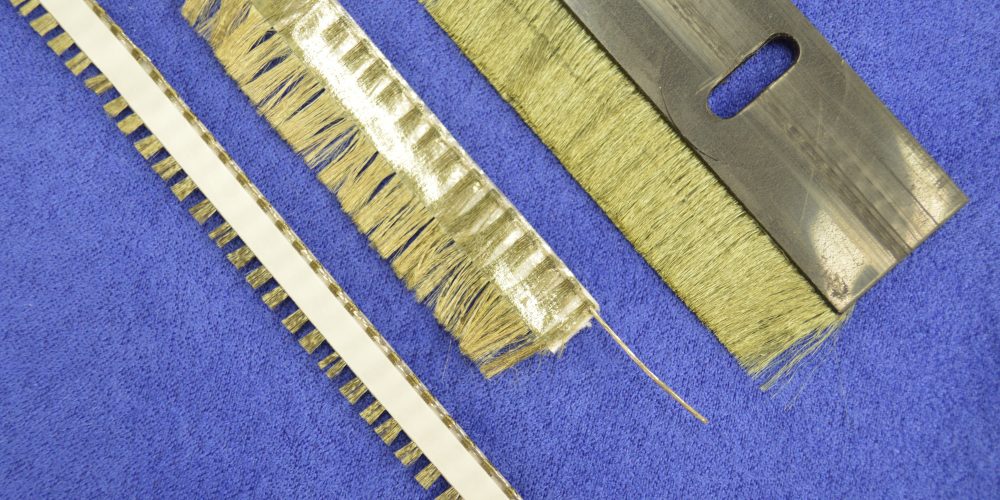How to Select an Anti-Static Brush
Return to Blog
Are you trying to improve your product, reach compliance for a new market, or manufacture a new product – but aren’t sure what kind of anti-static brush is suitable? You’ll need static control for industrial applications such as high speed conveyor lines, sheet line extrusion equipment, or robotic pick and place machines. In this article, you will learn about anti-static materials and which brush options might be best for your application.
Why Choose Anti-Static Brushes?
A static charge is created each time you dry brush a surface. Tribo is the Greek word for “rubbing,” which is how we get the word triboelectric. The result of this electric charge can be critical if the environment is static-sensitive, such as munitions plants – the situation can become dangerous and even lethal. A charge can affect sensitive, expensive electronic components. The manufacturing industry has had many problems with static charge, especially when non-conductive and ungrounded conductive parts are machined or moved.
Static charges can be very large – a walk across a carpet in dry weather with leather shoes on can create about 30,000v of static charge. That’s the same amount that flicks a light on!
3 Types of Anti-Static Brushes
The term anti-static is used interchangeably to encompass low charging brushes, static dissipative brushes, and conductive brushes. These three types of brushes have their own unique properties and specific uses.
1. Conductive Properties
When you have an application that requires a static charge of 0v, conductive brushes are ideal. Even a small charge may prevent the operation from performing optimally. As your product is discharged from the machine, it’s not sensitive to high current flow.
For example, think of the brushes inside a copier. Even though the static charge on the paper is small, it’s enough to make the sheets of paper cling to each other. The rapid discharge creates an electric current that affects the paper, but the conductive fiber doesn’t harm the equipment. A similar concept: if you shave a plastic block and then try to brush the plastic chips away, the chips will cling to the plastic block. Although the rapid discharge doesn’t affect the plastic, the small charge is a problem.
2. Static Dissipative Brushes
If you have a product that would be damaged by a high current flow during discharge, we recommend static dissipative brushes. These brushes reduce the current flow proportionally by introducing a high resistance between the charged surface and the resting surface of the equipment.
Static dissipative brushes are the only fiber that we recommend when you’re working with Class 1 electrical components. However, these brushes don’t reduce the static charge to 0v. At some point, the electric charge cannot overcome the resistance and will remain on the product.
3. Low Charging Brushes
If a charge of <200v won’t affect your product, we recommend low charging brushes. These brushes don’t remove a pre-existing charge. They’re frequently used for anything that’s not electronic. The unique properties of the low charging natural fibers allow them to work with many different applications.
Brush Materials
Anti-static brushes can be made out of any one of three groups of materials:
- Natural fibers: goat hair, horsehair, tampico, and hog bristle
- Synthetic fibers: static dissipative nylon, Thunderon™, Statigo9, and carbon fiber
- Metal fibers: Brass, phosphor bronze, aluminum, and stainless steel (used for conductive brushes and some cleanroom applications)
For electronic applications, choose an anti-static brush that has small diameter fibers. The soft fibers abrade much slower than stiffer fibers, but accomplish the same result. If you’re going to use an anti-static brush for non-electronic purposes, you can use one with thick metal and synthetic fibers for a stiffer brush, and thin fibers for a softer brush. Always opt for the smallest diameter possible for your application to minimize brush wear.
Materials for the Handles
Wood is the least expensive option for brush handles but isn’t suitable for cleanrooms. Aluminum, brass, and stainless steel are most commonly used for conductive applications. Plastic can be modified to have either conductive or static dissipative properties.
Environmental Factors
Environmental factors such as temperatures, chemical environments, FDA requirements, and outgassing concerns influence which fiber and handle are best suited for your specific application.
Manual or Automated Applications
Is your application manual? If so, you will need to consider the shape and size of the handle. Handles should be comfortable for the user to use repetitively, without undue weight. The size matters too; small brushes can create extra work, but oversized brushes can be awkward to use. For automated applications, we can partner with you to custom-manufacture anti-static brushes to fit your equipment and processes.
Manufacturing Prototypes for Testing and Production
Need prototypes to test your product’s performance? As an industrial brush manufacturer, Ultrafab partners with engineers to ensure they receive the anti-static brush that offers optimal performance for the job. We have all the equipment and materials needed to manufacture anti-static brushes and the test lab to meet your qualifications. If you’re interested to learn more about how to choose the correct anti-static brush based on your application, please contact us. We’d be happy to talk about feasibility and fit.
Posted on December 1, 2017

